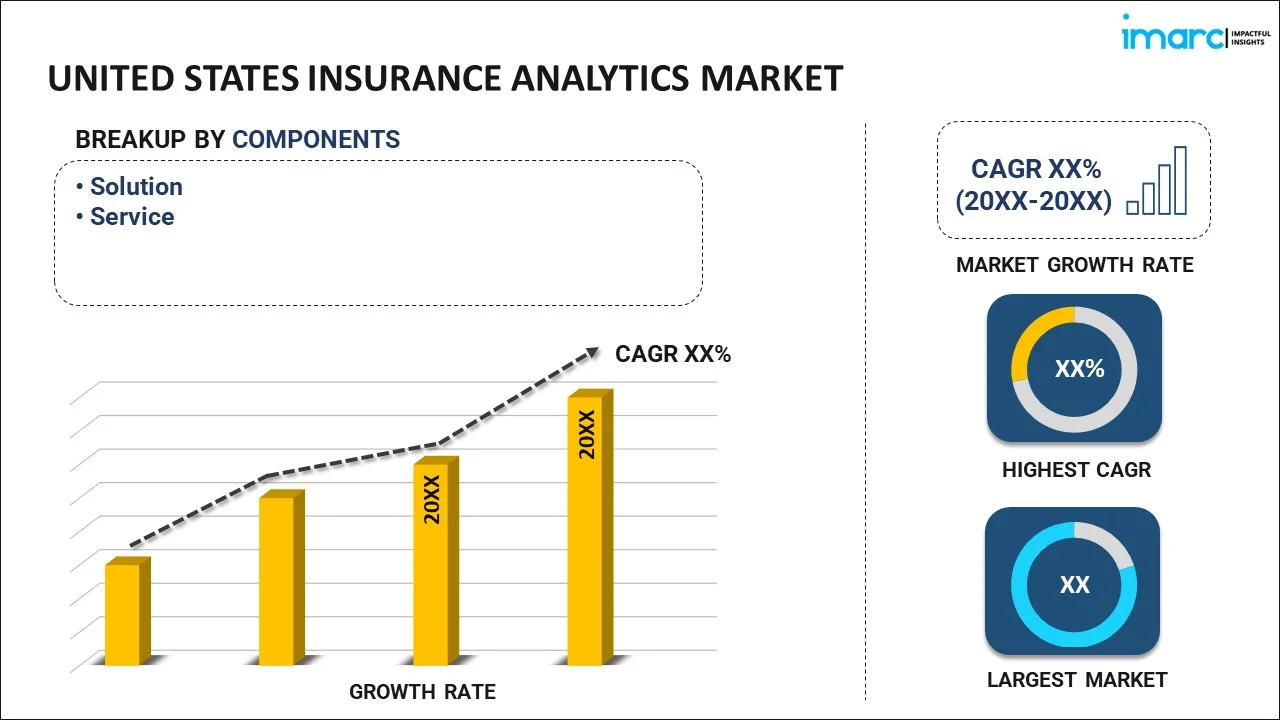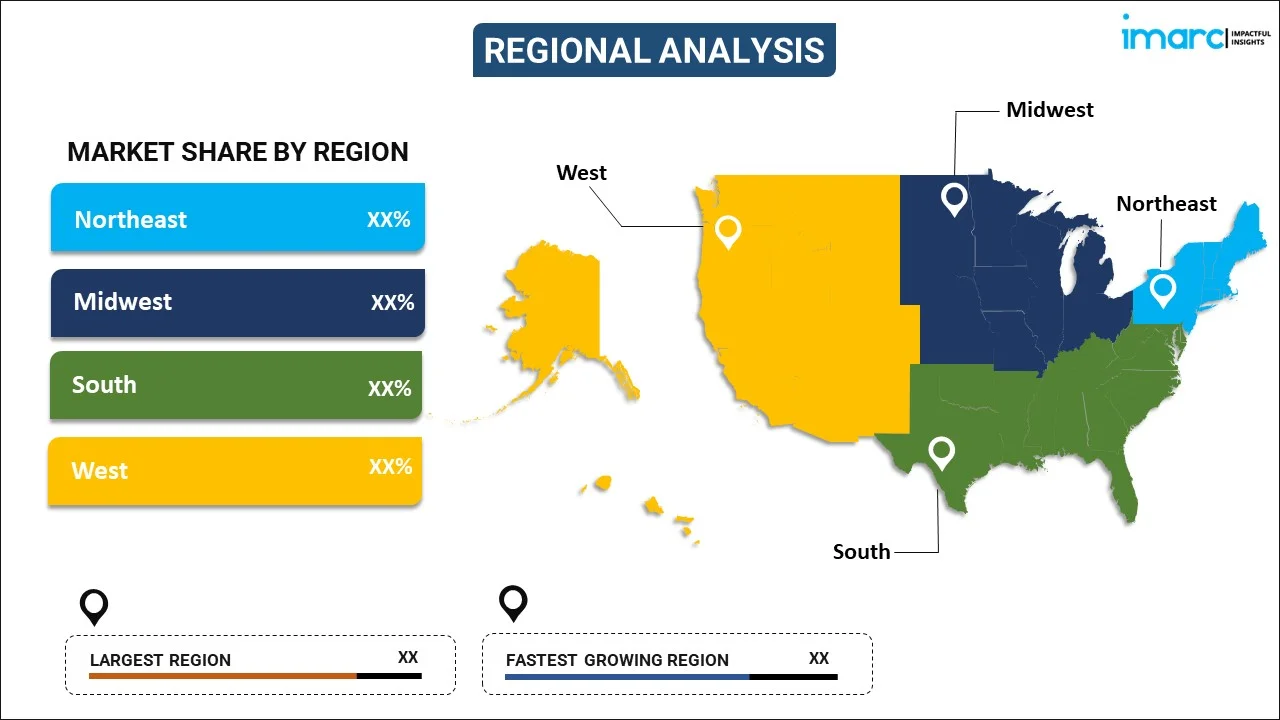
United States Insurance Analytics Market Report by Component (Solution, Service), Deployment Mode (On-premises, Cloud-based), Enterprise Size (Small and Medium-sized Enterprises, Large Enterprises), Application (Claims Management, Risk Management, Customer Management, Sales and Marketing, and Others), End User (Insurance Companies, Government Agencies, Third-party Administrators, Brokers and Consultancies), and Region 2025-2033
Market Overview:
United States insurance analytics market size reached USD 15.4 Billion in 2024. Looking forward, IMARC Group expects the market to reach USD 59.8 Billion by 2033, exhibiting a growth rate (CAGR) of 15.99% during 2025-2033. The increasing volume of data, which has necessitated advanced analytics tools to extract valuable insights, optimize processes, and make data-driven decisions, is driving the market.
|
Report Attribute
|
Key Statistics
|
|---|---|
|
Base Year
|
2024 |
|
Forecast Years
|
2025-2033
|
|
Historical Years
|
2019-2024
|
| Market Size in 2024 | USD 15.4 Billion |
| Market Forecast in 2033 | USD 59.8 Billion |
| Market Growth Rate (2025-2033) | 15.99% |
Insurance analytics refers to the use of data analysis and advanced statistical methods to extract meaningful insights from vast amounts of information within the insurance industry. It involves leveraging data to assess risk, predict future trends, and make informed decisions that enhance operational efficiency and profitability. Insurers use analytics to evaluate customer behavior, streamline underwriting processes, detect fraudulent activities, and optimize pricing strategies. Additionally, it enables the development of personalized insurance products, improving customer satisfaction and retention. By harnessing the power of analytics, insurance companies can make data-driven decisions, enhance risk management practices, and adapt to evolving market dynamics. Overall, insurance analytics plays a crucial role in transforming traditional insurance processes, fostering innovation, and ensuring the industry remains agile in the face of changing economic and technological landscapes.
United States Insurance Analytics Market Trends:
The insurance analytics market in the United States is experiencing robust growth, driven by various factors that collectively contribute to its expansion. Firstly, the increasing volume of data generated within the insurance industry is a pivotal driver. As insurers gather vast amounts of data from diverse sources, the demand for analytics solutions rises to extract meaningful insights. Moreover, the growing complexity of risks and the need for accurate risk assessment propel the adoption of analytics tools in the insurance sector. Additionally, the rising awareness of the benefits of data-driven decision-making among insurers fosters a favorable environment for the market. Furthermore, advancements in technology, particularly in artificial intelligence and machine learning, play a significant role in shaping the insurance analytics market. The integration of these technologies enhances the capabilities of analytics solutions, enabling insurers to streamline processes, improve efficiency, and make more informed decisions. Additionally, the increasing focus on customer-centric approaches within the insurance industry to understand customer behavior, personalize offerings, and enhance customer satisfaction is expected to drive the market in the United States during the forecast period.
United States Insurance Analytics Market Segmentation:
IMARC Group provides an analysis of the key trends in each segment of the market, along with forecasts at the country levels for 2025-2033. Our report has categorized the market based on component, deployment mode, enterprise size, application, and end user.
Component Insights:

- Solution
- Service
The report has provided a detailed breakup and analysis of the market based on the component. This includes solution and service.
Deployment Mode Insights:
- On-premises
- Cloud-based
A detailed breakup and analysis of the market based on the deployment mode have also been provided in the report. This includes on-premises and cloud-based.
Enterprise Size Insights:
- Small and Medium-sized Enterprises
- Large Enterprises
The report has provided a detailed breakup and analysis of the market based on the enterprise size. This includes small and medium-sized enterprises and large enterprises.
Application Insights:
- Claims Management
- Risk Management
- Customer Management
- Sales and Marketing
- Others
A detailed breakup and analysis of the market based on the application have also been provided in the report. This includes claims management, risk management, customer management, sales and marketing, and others.
End User Insights:
- Insurance Companies
- Government Agencies
- Third-party Administrators, Brokers and Consultancies
The report has provided a detailed breakup and analysis of the market based on the end user. This includes insurance companies, government agencies, and third-party administrators, brokers and consultancies.
Region Insights:

- Northeast
- Midwest
- South
- West
The report has also provided a comprehensive analysis of all the major regional markets, which include Northeast, Midwest, South, and West.
Competitive Landscape:
The market research report has also provided a comprehensive analysis of the competitive landscape. Competitive analysis such as market structure, key player positioning, top winning strategies, competitive dashboard, and company evaluation quadrant has been covered in the report. Also, detailed profiles of all major companies have been provided.
United States Insurance Analytics Market Report Coverage:
| Report Features | Details |
|---|---|
| Base Year of the Analysis | 2024 |
| Historical Period | 2019-2024 |
| Forecast Period | 2025-2033 |
| Units | Billion USD |
| Scope of the Report | Exploration of Historical and Forecast Trends, Industry Catalysts and Challenges, Segment-Wise Historical and Predictive Market Assessment:
|
| Components Covered | Solution, Service |
| Deployment Modes Covered | On-premises, Cloud-based |
| Enterprise Sizes Covered | Small and Medium-sized Enterprises, Large Enterprises |
| Applications Covered | Claims Management, Risk Management, Customer Management, Sales and Marketing, Others |
| End Users Covered | Insurance Companies, Government Agencies, Third-party Administrators, Brokers and Consultancies |
| Regions Covered | Northeast, Midwest, South, West |
| Customization Scope | 10% Free Customization |
| Post-Sale Analyst Support | 10-12 Weeks |
| Delivery Format | PDF and Excel through Email (We can also provide the editable version of the report in PPT/Word format on special request) |
Key Questions Answered in This Report:
- How has the United States insurance analytics market performed so far and how will it perform in the coming years?
- What has been the impact of COVID-19 on the United States insurance analytics market?
- What is the breakup of the United States insurance analytics market on the basis of component?
- What is the breakup of the United States insurance analytics market on the basis of deployment mode?
- What is the breakup of the United States insurance analytics market on the basis of enterprise size?
- What is the breakup of the United States insurance analytics market on the basis of application?
- What is the breakup of the United States insurance analytics market on the basis of end user?
- What are the various stages in the value chain of the United States insurance analytics market?
- What are the key driving factors and challenges in the United States insurance analytics?
- What is the structure of the United States insurance analytics market and who are the key players?
- What is the degree of competition in the United States insurance analytics market?
Key Benefits for Stakeholders:
- IMARC’s industry report offers a comprehensive quantitative analysis of various market segments, historical and current market trends, market forecasts, and dynamics of the United States insurance analytics market from 2019-2033.
- The research report provides the latest information on the market drivers, challenges, and opportunities in the United States insurance analytics market.
- Porter's five forces analysis assist stakeholders in assessing the impact of new entrants, competitive rivalry, supplier power, buyer power, and the threat of substitution. It helps stakeholders to analyze the level of competition within the United States insurance analytics industry and its attractiveness.
- Competitive landscape allows stakeholders to understand their competitive environment and provides an insight into the current positions of key players in the market.
Need more help?
- Speak to our experienced analysts for insights on the current market scenarios.
- Include additional segments and countries to customize the report as per your requirement.
- Gain an unparalleled competitive advantage in your domain by understanding how to utilize the report and positively impacting your operations and revenue.
- For further assistance, please connect with our analysts.
 Inquire Before Buying
Inquire Before Buying
 Speak to an Analyst
Speak to an Analyst
 Request Brochure
Request Brochure
 Request Customization
Request Customization




.webp)




.webp)












